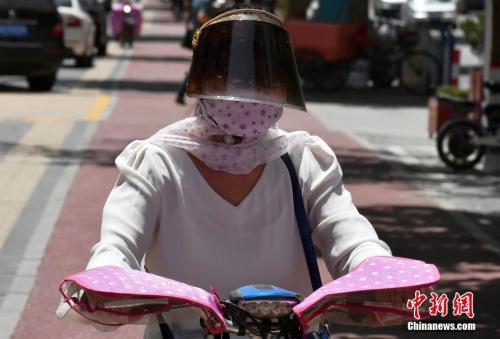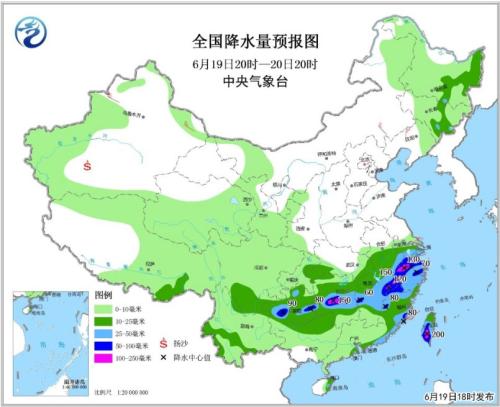Many places in the north entered the "sunny mode", and heavy rains in the south involved 10 provinces.
BEIJING, Beijing, June 20 (Xinhua) In recent days, many places in the north have once again ushered in the "sunny mode". With the expansion of the sphere of influence of high temperature weather, from today, there will be high temperature weather lasting for many days in Huanghuai, North China, with the highest temperature reaching 35 ~ 38 C. In the south, rainfall has become the key word of weather, and the areas affected by heavy rain involve 10 provinces.

Data Map: At noon on June 5, the temperature in Shijiazhuang reached 38℃, and citizens traveled with various sunshade protective gear. China News Service reporter Yujia Zhai photo
Many places in the north enter the "sunny mode" and the meteorological conditions of ozone pollution are high.
After the Dragon Boat Festival holiday, the high temperature once again visited many places in the north, and the sphere of influence of high temperature in Huanghuai area of North China continued to expand. According to the weather forecast, after 20 days, some areas in eastern North China and Huanghuai will have high temperature weather for 4 to 6 days, with the highest temperature reaching 35 to 38℃.
In Beijing, the Beijing Meteorological Observatory issued a blue warning of high temperature at 16: 40 on the 19th. It is estimated that the daily maximum temperature in most parts of Beijing will reach above 35℃ from 20th to 21st.
Not only in Beijing, but also in the southern part of North China and the central and western parts of Huanghuai today and tomorrow, high temperatures will continue to spread. Among provincial-level cities, Tianjin, Shijiazhuang and Zhengzhou will have high temperatures today and tomorrow. From the 21st, Jinan will have high temperatures for five consecutive days.
As the "sunshine mode" is on, according to the news of the Central Meteorological Observatory, the meteorological conditions of ozone pollution in central and southern North China, Huanghuai and other places are relatively high from the 20th, with the meteorological conditions of ozone pollution ranging from 3 to 4, and the local level in central and southern North China can reach 5.
Take Beijing-Tianjin-Hebei and its surrounding areas as an example. From 20 to 25, the central and southern parts of the region have strong solar radiation and high temperature, which is conducive to ozone generation. The meteorological conditions of ozone pollution are maintained at level 3 to 4, and the local level can reach level 5.
According to meteorologists, ozone pollution will decompose rapidly indoors because it needs high temperature and ultraviolet radiation. Experts remind that for photochemical pollution dominated by ozone, it is of little use for people to wear masks. The most important way to prevent photochemical pollution is to avoid going out as much as possible and close doors and windows at the same time.

Heavy rain in the south involves 10 provinces, Zhejiang and Hunan.JiangxiThere is a heavy rain in the local area.
High temperature weather spread in the north, while in the south, especially in the middle and lower reaches of the Yangtze River, these areas that entered the "rainy season" ushered in continuous heavy rainfall. In response to the rainstorm, the Central Meteorological Observatory has issued blue and yellow rainstorm warnings for several consecutive days.
According to the weather bulletin of the Central Meteorological Observatory, during the daytime on the 19th, heavy rains occurred in parts of central Anhui, northern Shanghai, northeastern Guizhou and southeast coastal areas of Guangdong, and heavy rains (101 mm) occurred in Tongren, Guizhou. At 18: 00 on the 19th, the Central Meteorological Observatory issued a blue rainstorm warning again.
It is estimated that there will be heavy rains in southern Anhui, Shanghai, Zhejiang, central and northeastern Jiangxi, central Hunan and central Guizhou from 20: 00 on the 19th to 20: 00 on the 20th, among which there will be heavy rains (100-150 mm) in western Zhejiang, northeastern Jiangxi and central Hunan. Some of the above areas are accompanied by short-term heavy precipitation (the maximum hourly precipitation is 20 ~ 50 mm, and the local area is more than 60 mm), and there are thunderstorms and strong winds in the local area.
In addition, there are heavy rains and local heavy rains in the northwestern and eastern coastal areas of Fujian, the southeastern coastal areas of Guangdong and Taiwan Province Island.
The Central Meteorological Observatory reminded that during the process of heavy rainfall in the south of the Yangtze River and Huaihe River, it is necessary to pay attention to disasters such as urban waterlogging and landslides that may be caused by local heavy rainfall, as well as the adverse effects of strong convective weather such as thunderstorms and strong winds.

From the evening of June 18th to the morning of 19th, heavy rain fell in dangyang city, Hubei Province, and some residents were trapped. Fire officers and soldiers in dangyang city City were dispatched to evacuate the trapped people. Liu bangpei
The rainfall in the middle and lower reaches of the Yangtze River is concentrated, and the Yangtze River Defense General deploys flood control again
Since the Dragon Boat Festival holiday, the heavy rainfall in the middle and lower reaches of the Yangtze River has continued to attract attention. The National Defense General, the Ministry of Water Resources and other departments have repeatedly discussed and judged the rain and flood situation and deployed flood control emergency work.
According to the forecast of the Central Meteorological Observatory, the main rain belt of heavy rainfall in the south will be located in the south of the Yangtze River on 20-22, and then it will be carried to the middle and lower reaches of the Yangtze River in the north, and the middle and lower reaches of the Yangtze River will enter the rainfall concentration period.
According to the website of the Ministry of Water Resources, on the 18th, the Yangtze River Defense General once again held a meeting on the recent flood control situation in the Yangtze River basin, and deployed the dispatching work of the Three Gorges and Danjiangkou reservoirs.
The Yangtze River Defense General issued a dispatch order to dispatch Danjiangkou Reservoir to open two surface holes for flood discharge at 18: 00 on the 18th. At the same time, the General Office of the Yangtze River Defense issued a notice to the Hubei Provincial Defense Index, demanding that the flood control work in the middle and lower reaches of the Han River be effectively carried out. According to the deployment of the National Defense President, the Yangtze River Defense General sent a working group to Jiangxi to help guide the flood control work.
Ma Jianhua, executive deputy commander of the Yangtze River Defense General and director of the Yangtze River Water Resources Commission, said that the Yangtze River Basin has entered a period of continuous heavy rainfall concentration, and all relevant departments and units should further attach great importance to it and overcome the luck and paralysis; It is necessary to further strengthen the implementation of responsibilities and do a good job in flood control duty and emergency duty. (End)